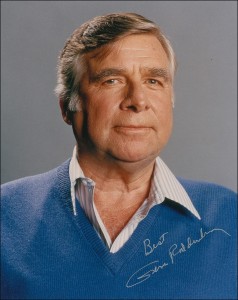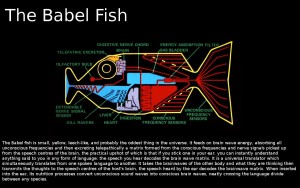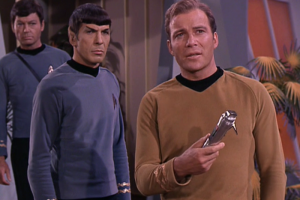Peter Lobner
By now, everyone knows that Gene Roddenberry originally created Star Trek as a utopian science fiction TV series. The pilot episode, “The Cage,” started filming on 27 November 1964 at the Desilu Productions studios, in Culver City, CA. The main cast members were Jeffrey Hunter (Capt. Christopher Pike), Roddenberry’s wife Majel Barrett (first officer, known as “Number One”), Leonard Nimoy (Mr. Spock), and John Hoyt (ship’s doctor, Dr. Philip Boyce) and their starship was the Enterprise. Filming and post-production were completed in January 1965. However, this pilot was not well received by NBC executives.
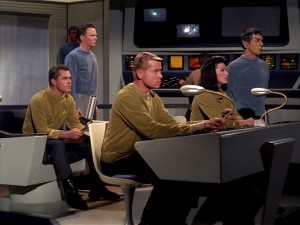 Main cast for “The Cage” pilot. Source: thespacereview.com
Main cast for “The Cage” pilot. Source: thespacereview.com
On the cnet.com website, Richard Trenholm reported:
“Unfortunately, NBC deemed the pilot episode “too cerebral” with “not enough action” — and demanded that Roddenberry “get rid of the guy with the ears”. But in a then-unprecedented move, NBC commissioned a second pilot. Hunter declined to be involved, so Shatner took over the conn as Capt. Kirk when the series began transmission on 8 September 1966. The rest is history.”
“The Cage” finally was released on VHS in 1986 and was broadcast for the first time in November 1988. You can watch the “The Cage,” at the following link:
http://www.disclose.tv/action/viewvideo/104239/Star_Trek_the_Cage/
Lucille Ball (the “lu” in Desilu Studios) is credited with supporting Gene Roddenberry’s plans for the original Star Trek TV series, and doubtless was instrumental in getting NBC to sponsor the second pilot. Thank you, Lucy! The second pilot, “Where No Man Has Gone Before,” had most of the main cast members that became fixtures in the original TV series: William Shatner (Capt. James Kirk), Leonard Nimoy (Science Officer, Mr. Spock), James Doohan (Chief Engineer, Montgomery Scott), and George Takei (Lt. Sulu). Mark Piper preceded series regular DeForest Kelly as the ship’s doctor. Nichelle Nichols (Communications Officer, Lt. Uhura) had not yet joined the cast. NBC approved the second pilot and the TV series was launched, but not by the second pilot. The second pilot actually was the third Star Trek episode broadcast in the U.S. on 22 September 1966.
The first U.S. broadcast episode of Star Trek was “The Man Trap,” which was the sixth episode filmed. This episode was broadcast by NBC on 8 September 1966 in the U.S., two days after it was broadcast in Canada.
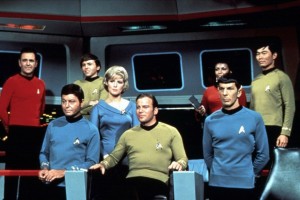 Star Trek the original series (TOS) crew of the Enterprise. Source: buzz.ie
Star Trek the original series (TOS) crew of the Enterprise. Source: buzz.ie
Confused? Well there’s more. The plot of “The Cage” actually was salvaged and incorporated into Season 1 episodes 11 & 12, “The Menagerie,” with Jeffrey Hunter again playing the part of a now seriously injured Fleet Capt. Christopher Pike.
The original series lasted three seasons and produced 79 episodes by the time the last episode, “Turnabout Intruder,” was broadcast on 3 June 1969. The good news is that there were enough episodes for Star Trek to enter syndication, permitting endless re-runs to entertain a growing fan base for generations after the original series was cancelled.
You’ll find a list of all episodes in the original series at the following link:
https://en.wikipedia.org/wiki/List_of_Star_Trek:_The_Original_Series_episodes
From here, you can easily navigate to find details on each individual episode.
The original Star Trek’s series spawned five additional television series, thirteen feature films, a host of books and comics / graphic novels, and a huge variety of “toys,” which by now have become highly collectable treasures.
In 1976, the National Aeronautics and Space Administration (NASA) named their first space shuttle Enterprise in honor of the starship in the original Star Trek series. The original cast members joined NASA and other officials for the rollout the North American Rockwell facility in Palmdale, CA.
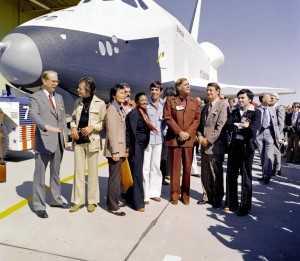 Source: NASA. From left to right they are: NASA Administrator Dr. James D. Fletcher; DeForest Kelley, who portrayed Dr. “Bones” McCoy on the series; George Takei (Mr. Sulu); James Doohan (Chief Engineer Montgomery “Scotty” Scott); Nichelle Nichols (Lt. Uhura); Leonard Nimoy (Mr. Spock); series creator Gene Roddenberry; U.S. Rep. Don Fuqua (D.-Fla.); and, Walter Koenig (Ensign Pavel Chekov)
Source: NASA. From left to right they are: NASA Administrator Dr. James D. Fletcher; DeForest Kelley, who portrayed Dr. “Bones” McCoy on the series; George Takei (Mr. Sulu); James Doohan (Chief Engineer Montgomery “Scotty” Scott); Nichelle Nichols (Lt. Uhura); Leonard Nimoy (Mr. Spock); series creator Gene Roddenberry; U.S. Rep. Don Fuqua (D.-Fla.); and, Walter Koenig (Ensign Pavel Chekov)
Gene Roddenberry and the writers of the original Star Trek series deserve a lot of credit for envisioning a very different culture and an optimistic future while creating the series during a period of great political and social strife in the U.S. during the late 1960s. They also deserve credit for conceiving a whole range of advanced technologies that were needed to support their spacefaring mythology. Many of these Star Trek technologies seem to be less science fiction today than they did 50 years ago because we now have many new products and services that embody analogous technologies, or at least some rudimentary aspects of some of the Star Trek technologies.
Many of the technologies in Star Trek TOS still elude us in 2016, but these will be exciting challenges for scientists and engineers during the next 50 years.
- Warp drive, for faster-than-light travel
- Usable power generation from fusion reactions (for the impulse engines)
- Usable power generation from matter – anti-matter reactions (for the warp drive)
- Sub-space communications, for faster-than-light communications
- Gravity plating, to simulate a gravity field inside a starship
- Inertial dampeners, to counter the effects of rapid acceleration and deceleration
- Shields, for absorbing the energy from incoming weapons and minimizing damage to the starship and crew
- Tractor beam, for capturing objects at a distance and reeling them in. A microscopic scale tractor beam has been demonstrated in the laboratory.
- Transporter, for dematerializing a person or object in one location and rematerializing the same person or object in a different location.
- Time travel, for moving persons, objects, or whole starships into a different time continuum than our own
- Suspended animation of humans, for long duration spaceflight
- Neutronium, for impermeable armor / shielding
Gene Roddenberry and his writing staff incorporated all of these technologies into the original Star Trek mythology in the first year of the series. Later Star Trek series and movies introduced a host of additional technologies, including:
You can read more on Star Trek technologies at the following links:
NASA, 20 July 2016: “The Science of Star Trek”
http://www.nasa.gov/topics/technology/features/star_trek.html
Popular Science, 21 July 2016: “Status Report: 7 ‘Star Trek’ Technologies Under Development”
http://www.popsci.com/star-trek-technologies-where-are-they-now
Forbes, 24 June 2014: “8 Star Trek Technologies Moving From Science Fiction To Science Fact”
http://www.forbes.com/sites/paulhsieh/2014/06/24/8-star-trek-technologies/3/#722b17c3aa4d
Thanks again to Gene Roddenberry for creating the original Star Trek series, which led to a whole body of engaging spacefaring mythology that is certain to endure. Happy 50th anniversary!


